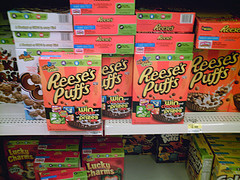Kids’ Cereals Are More Nutritious, But Ads Are Still Pushing The Unhealthiest Stuff
A new report says that while the good news is that U.S. food companies are doing kids a healthy favor by cutting out sugar and tossing in some more whole grains, all the benefits of those actions are being undermined by more ads featuring their unhealthiest products, targeted directly at kids.
The “Cereal Facts” study from Yale University’s Rudd Center for Food Policy & Obesity found that many companies like Kellogg, General Mills and Post have improved the nutrition profile with many recipe tweaks, but there’s still plenty of room for improvement, reports Reuters.
“It’s not enough and the companies are still using all their marketing muscle to push their worst cereals on children,” Kelly Brownell, director of the Rudd Center said.
While some of the highest scoring cereals on the nutrition scale were regular Cheerios and Frosted Mini-Wheats, those are usually marketed to adults. Meanwhile, the report pointed out the aggressive ad tactics for cereals like Reese’s Puffs, Froot Loops and Fruity Pebbles, aimed right at kids. Those brands have the lowest nutrition and highest added sugar.
Ad dollars splashed out to promote child-targeted cereals was up 33% from 2008, the last time the group did a study, at $264 million.
Food companies have agreed to regulate themselves through the Council of Better Business Bureaus’ Children’s Food and Beverage Advertising Initiative, instead of being subject to direct government oversight. Kellog, General Mills and Post have all agreed to stick to nutrition criteria for any products advertised to kids under 12.
“Changing kids’ taste preferences takes time and effort. The notion that kids could stop eating Froot Loops and go and have Grape-Nuts, with all due respect to Grape-Nuts, to me is unrealistic and not practical,” said Elaine Kolish, director of CFBAI.
She says now most cereals have no more than 10 grams of sugar, compared to the 15 to 16 grams that were common before CFBAI was founded.
However, the American Heart Association points out that many kids are eating twice the serving size of breakfast cereal that they should be.
“Before they leave the house in the morning, children eating these presweetened cereals will have consumed as much sugar as they should eat in an entire day,” it said.
Previously in over-sweetened children: Disney Networks To Stop Airing Junk Food Ads To Kids; Government Proposes New Guidelines For Marketing Food To Kids
Kids’ cereals are healthier, ads aren’t — report [Reuters]
Want more consumer news? Visit our parent organization, Consumer Reports, for the latest on scams, recalls, and other consumer issues.


